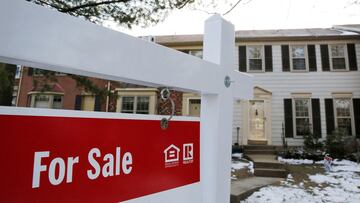What will interest in the spring housing market look like?
Mortgage rates have continued to fall since their high in December 2022, but should buyers count on this trend continuing through the spring?


At 6.66 percent, the average rate for a 30-year fixed mortgage in the United States hit its highest level since the early 2000s in late 2022.
In February 2023, rates for a 30-year mortgage fell to an average of 6.26 percent.
In late March, the Federal Reserve bumped rates up around twenty-five basis points, leading the Effective Federal Funds rate to reach 4.87 percent. In response, the cost of a traditional mortgage began to rise again, with the 30-year rate increasing to 6.32 by the end of March.
The Federal Reserve as the lender of last resort
The Federal Reserve, as the lender of last resort, sets a base interest rate to insulate the economy risks that could destabilize capital markets. When rates are higher, firms hoping to turn that credit into profit must ensure that they invest in ways that will generate a profit. This may be done by firing workers and forcing those who remain to work longer hours or by avoiding high-risk investments that could leave the firm open to losses. To protect themselves against market risks and uncertainty, lending firms, like those in the mortgage business, will set their rates above those established by the Fed. So as the central bank moves up interest rates, borrowing money for firms and households becomes more expensive because the rates they are offered by lending banks increase as well.
The number of houses sold begins to fall
Since 2019, the median price of a home sold in the US has increased by a staggering forty-two percent.
The low interest rate environment throughout the Covid pandemic only made this problem worse.
— Mark Wlosinski (@LTI_finance) April 1, 2023
Buyers flooded the market driving home prices higher even faster than before.
The median existing home price in February of 2023 was $379,000 (up 14.3% from 2022)
In an attempt to cool this market and the economy more widely, the Federal Reserve responded by increasing interest rates. The act of increasing interest rates makes taking out a mortgage more expensive, which limits demand as some buyers are priced out. The impact of these rate hikes is only starting to be felt, and while the number of houses sold has begun to fall, prices have shown themselves to be many stickers.
In March 2022, before the Fed began to increase rates, the median selling price of a home was $436,700, and around 763,000 were sold. Nearly a year later, in February 2023, the median price had moved up to $438,200, but the number of homes sold dropped by more than 100,000 to 640,000. Aside from December 2022, when 839,000 homes were sold, the numbers have been trending downward.
| Month | 30-Year Fixed Rate Mortgage | Effective Federal Fund Rate | Median Home Price | Number of Homes Sold |
|---|---|---|---|---|
| March 2022 | 4.17 | 0.33 | $436,700 | 763,000 |
| September 2022 | 6.11 | 3.08 | $470,600 | 588,000 |
| October 2022 | 6.90 | 3.08 | $493,000 | 632,000 |
| November 2022 | 6.81 | 3.83 | $471,200. | 602,000 |
| December 2022 | 6.36 | 4.33 | $442,100. | 839,000 |
| January 2023 | 6.27 | 4.33 | $427,500 | 633,000 |
| February 2023 | 6.26 | 4.47 | $438,200 | 640,000 |
The fact that demand has fallen and prices haven’t is an indication that those who remain in the market a willing to pay a higher price. Additional information on the buyer profile and whether they are a first-time home buyer, a retired couple looking to downsize, or a private business hoping to rent out the properties would be helpful in understanding the effect of rate hikes across these profiles. If rate hikes price out young families and first-time buyers but not Wall Street investment firms and property management companies, prices are not likely to fall. Yardi Matrix, a market research firm geared towards investors, projects that by 2030, forty percent of single-family homes in the US could be owned by institutions on Wall Street. This consolidation and ownership would likely push prices up even higher as these investors have been known to keep homes vacant to limit supply. If prices remain where they are, it could be a sign that rate increases are sidelining working-class families and other economically vulnerable groups by forcing them to compete against major financial institutions with nearly endless capital.
However, it could also be that prices tend to have a lagging effect, meaning that as demand falls, prices decrease do follow, just at a slower rate.
Experts project mortgage rates to fall by the end of the year
Reporters with Forbes asked Navy Federal Credit Union economist Robert Frick where he thought mortgage rates would go by the end of the year, and his advice to potential buyers was to “be prepared to jump on a dip in rates.” However, this advice only applies to those who “have a property in mind that fits [their] budget.” Frick warns that economic uncertainty creates additional risk for buyers because if they purchase a home outside of their budget and prices begin to fall, they will be underwater on their mortgage.
Related stories
Some organizations like the Mortgage Bankers Association project rates to fall to 5.2 percent by the end of the year, having already “peaked” in late 2022. But others, like government-sponsored loan corporation Freddie Mac, are not so sure, estimating that by Q4 2023, rates will sit around 6.2 percent.
Short term outlook
Market conditions are highly uncertain at this time, but those still looking to buy a home should not expect rates to fall far from their current position before the summer. The Fed is expected to continue pushing rates up and will likely do so until housing prices continue to fall since they are now driving inflation. The Bureau of Labor Statistics reported that seventy percent of the 0.4 percent increase in the Consumer Price Index was driven by housing costs.

